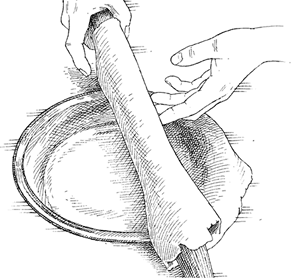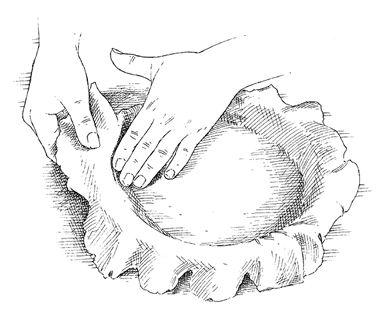The Cook's Illustrated Cookbook (327 page)
Read The Cook's Illustrated Cookbook Online
Authors: The Editors at America's Test Kitchen
Tags: #Cooking

MAKES ENOUGH FOR ONE 9-INCH PIE
Vodka is essential to the tender texture of this crust and imparts no flavor—do not substitute water. This dough is moister than most standard pie doughs and will require lots of flour to roll out (up to ¹⁄
4
cup). For more information on creating a decorative edge, see
“MAKING A DECORATIVE EDGE ON A SINGLE-CRUST PIE”
.
1¹⁄ | cups (6¹⁄ |
1 | tablespoon sugar |
¹⁄ | teaspoon salt |
6 | tablespoons unsalted butter, cut into ¹⁄ |
4 | tablespoons vegetable shortening, cut into 2 pieces and chilled |
2 | tablespoons vodka, chilled |
2 | tablespoons ice water |
1.
Process ³⁄
4
cup flour, sugar, and salt together in food processor until combined, about 5 seconds. Scatter butter and shortening over top and continue to process until incorporated and mixture begins to form uneven clumps with no remaining floury bits, about 10 seconds.
2.
Scrape down bowl and redistribute dough evenly around processor blade. Sprinkle remaining ¹⁄
2
cup flour over dough and pulse until mixture has broken up into pieces and is evenly distributed around bowl, 4 to 6 pulses.
3.
Transfer mixture to medium bowl. Sprinkle vodka and ice water over mixture. Stir and press dough together, using stiff rubber spatula, until dough sticks together.
4.
Turn dough onto sheet of plastic wrap and flatten into 4-inch disk. Wrap tightly in plastic and refrigerate for 1 hour. Before rolling dough out, let it sit on counter to soften slightly, about 10 minutes. (Dough can be wrapped tightly in plastic and refrigerated for up to 2 days or frozen for up to 1 month. If frozen, let dough thaw completely on counter before rolling it out.)
5.
Adjust oven rack to middle position and heat oven to 425 degrees. Roll dough into 12-inch circle on floured counter. Loosely roll dough around rolling pin and gently unroll it onto 9-inch pie plate, letting excess dough hang over edge. Ease dough into plate by gently lifting edge of dough with one hand while pressing into plate bottom with other hand. Leave any dough that overhangs plate in place. Wrap dough-lined pie plate loosely in plastic and refrigerate until dough is firm, about 30 minutes.
6.
Trim overhang to ¹⁄
2
inch beyond lip of pie plate. Tuck overhang under itself; folded edge should be flush with edge of pie plate. Crimp dough evenly around edge of pie using your fingers. Wrap dough-lined pie plate loosely in plastic and refrigerate until dough is fully chilled and firm, about 15 minutes, before using.
7.
Line chilled pie shell with double layer of aluminum foil, covering edges to prevent burning, and fill with pie weights.
8A. FOR A PARTIALLY BAKED CRUST:
Bake until pie dough looks dry and is pale in color, about 15 minutes. Remove weights and foil and continue to bake crust until light golden brown, 4 to 7 minutes longer. Transfer pie plate to wire rack and remove weights and foil. (Crust must still be warm when filling is added.)
8B. FOR A FULLY BAKED CRUST:
Bake until pie dough looks dry and is pale in color, about 15 minutes. Remove weights and foil and continue to bake crust until deep golden brown, 8 to 12 minutes longer. Transfer pie plate to wire rack and let crust cool completely, about 1 hour.

1.
After rolling out dough, loosely roll it around rolling pin, then gently unroll it evenly onto pie plate.

2.
Lift up edges of dough and ease it down into lower creases of pan. Press lightly to adhere dough to sides of pan.
![]() WHY THIS RECIPE WORKS
WHY THIS RECIPE WORKS
All-butter pie doughs possess great flavor, but they often fail to be flaky and are notoriously difficult to work with. We wanted an all-butter dough that was easier to mix, handle, and roll, producing a pie crust with all the tenderness and flavor that the description “all-butter” promises. We initially tried to make the dough easier to handle by reducing the amount of butter, but this resulted in a bland flavor and dry texture. Rather than adding back the subtracted butter, we experimented with other forms of fat, including heavy cream, cream cheese, and sour cream. We found that sour cream not only added flavor but, because acid reduces gluten development, it also helped keep the dough tender and flaky. To mix the dough, we used a food processor, which brought the ingredients together quickly and evenly.
See “MAKING A DECORATIVE EDGE ON A SINGLE-CRUST PIE” illustrations that follow recipe.
MAKES ENOUGH FOR ONE 9-INCH PIE
Freezing the butter for 10 to 15 minutes is crucial to the flaky texture of this crust. If preparing the dough in a very warm kitchen, refrigerate all of the ingredients before making the dough. If you don’t have a food processor, see
“TEST KITCHEN TIP NO. 142 HAND MIXING PIE DOUGH”
.
¹⁄ | cup ice water, plus extra as needed |
3 | tablespoons sour cream |
2¹⁄ | cups (12¹⁄ |
1 | tablespoon sugar |
1 | teaspoon salt |
16 | tablespoons unsalted butter, cut into ¹⁄ |
1.
Mix ice water and sour cream together in bowl until combined. Process flour, sugar, and salt together in food processor until combined, about 5 seconds. Scatter butter over top and pulse mixture until butter is size of large peas, about 10 pulses.
2.
Pour half of sour cream mixture over flour mixture and pulse until incorporated, about 3 pulses. Repeat with remaining sour cream mixture. Pinch dough with your fingers; if dough feels dry and does not hold together, sprinkle 1 to 2 tablespoons more ice water over mixture and pulse until dough forms large clumps and no dry flour remains, 3 to 5 pulses.
3.
Divide dough into 2 even pieces. Turn each piece of dough onto sheet of plastic wrap and flatten each into 4-inch disk. Wrap each piece tightly in plastic and refrigerate for 1 hour. Before rolling dough out, let it sit on counter to soften slightly, about 10 minutes. (Dough can be wrapped tightly in plastic and refrigerated for up to 2 days or frozen for up to 1 month. If frozen, let dough thaw completely on counter before rolling it out.)
MAKES ENOUGH FOR ONE 9-INCH PIE
Freezing the butter for 10 to 15 minutes is crucial to the flaky texture of this crust. If preparing the dough in a very warm kitchen, refrigerate all of the ingredients before making the dough. If you don’t have a food processor, see
“TEST KITCHEN TIP NO. 142 HAND MIXING PIE DOUGH”
.
4 | teaspoons sour cream |
3–4 | tablespoons ice water |
1¹⁄ | cups (6¹⁄ |
1¹⁄ | teaspoons sugar |
¹⁄ | teaspoon salt |
8 | tablespoons unsalted butter, cut into ¹⁄ |
1.
Mix sour cream and 3 tablespoons ice water together in bowl until combined. Process flour, sugar, and salt together in food processor until combined, about 5 seconds. Scatter butter over top and pulse mixture until butter is size of large peas, about 10 pulses.
2.
Pour half of sour cream mixture over flour mixture and pulse until incorporated, about 3 pulses. Repeat with remaining sour cream mixture. Pinch dough with your fingers; if dough feels dry and does not hold together, sprinkle remaining 1 tablespoon ice water over mixture and pulse until dough forms large clumps and no dry flour remains, 3 to 5 pulses.
3.
Turn dough onto sheet of plastic wrap and flatten into 4-inch disk. Wrap tightly in plastic and refrigerate for 1 hour. Before rolling dough out, let it sit on counter to soften slightly, about 10 minutes. (Dough can be wrapped tightly in plastic and refrigerated for up to 2 days or frozen for up to 1 month. If frozen, let dough thaw completely on counter before rolling it out.)
4.
Adjust oven rack to middle position and heat oven to 375 degrees. Roll dough into 12-inch circle on lightly floured counter. Loosely roll dough around rolling pin and gently unroll it onto 9-inch pie plate, letting excess dough hang over edge. Ease dough into plate by gently lifting edge of dough with one hand while pressing into plate bottom with other hand. Leave any dough that overhangs plate in place.
5.
Trim overhang to ¹⁄
2
inch beyond lip of pie plate. Tuck overhang under itself; folded edge should be flush with edge of pie plate. Crimp dough evenly around edge of pie using your fingers. Wrap dough-lined pie plate loosely in plastic and place in freezer until dough is fully chilled and firm, about 30 minutes, before using.
6.
Line chilled pie shell with double layer of aluminum foil, covering edges to prevent burning, and fill with pie weights.
7A. FOR A PARTIALLY BAKED CRUST:
Bake until pie dough looks dry and is light in color, 25 to 30 minutes. Transfer pie plate to wire rack and remove weights and foil. (Crust must still be warm when filling is added.)
7B. FOR A FULLY BAKED CRUST:
Bake until pie dough looks dry and is light in color, 25 to 30 minutes. Remove weights and foil and continue to bake crust until deep golden brown, 10 to 12 minutes longer. Transfer pie plate to wire rack and let crust cool completely, about 1 hour.
We like rolling our single-crust dough in fresh graham cracker crumbs because it adds flavor and crisp textural appeal to our custard pies.
Crush 3 whole graham crackers to fine crumbs. (You should have about ¹⁄
2
cup crumbs.) Dust counter with graham cracker crumbs instead of flour. Continue sprinkling dough with crumbs, both underneath and on top, as it is being rolled out.

1.
Using scissors, trim all but ¹⁄
2
inch of dough overhanging outer lip of plate.

2.
Tuck trimmed overhang under so that it is even with lip of plate.

3.
Create fluted edge around crust using index finger of one hand and thumb and index finger of other. Edge of dough should be perpendicular to edge of pie plate.